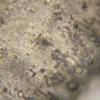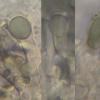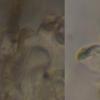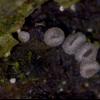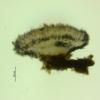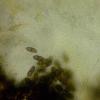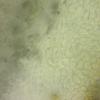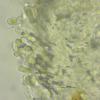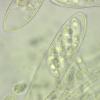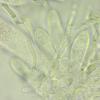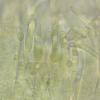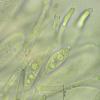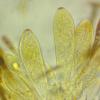
24-12-2025 17:08
Hulda Caroline HolteHello, I have found this propoloid ascomycete on

21-12-2025 09:32
Hello.A tiny ascomycete found embedded in wood in

21-12-2025 21:32
Pol DebaenstHello, Garden, Burgweg 19, Veurne, BelgiumOn 10/1

22-12-2025 23:38
Patrice TANCHAUDBonsoir, récolte sur un mur en pierre, apothéci

22-12-2025 00:47
Patrice TANCHAUDBonsoir, récolte à proximité du milieu dunaire
Cenangiaceae? on Swida
Viktorie Halasu,
22-11-2020 11:50
 Hello,
Hello, I would welcome any advice with this discomycete. Sessile, gray, ca. 0.5-0.75 mm diam, on attached dead < 1 cm thick twig of Swida sp. hanging about 1,75 m above ground, associated with a pyrenomycetous anamorph (?). Spores already 1-3-septate in asci, most of them germinating.
Riparian forest (Populus, Salix, Tilia) along a larger river, rather shaded from draught. Czech Rep., 250 m a.s.l.
I'm not sure where to place it, Cenangiaceae?
Thanks a lot in advance.
Viktorie
Viktorie Halasu,
22-11-2020 12:10
Hans-Otto Baral,
22-11-2020 18:25

Re : Cenangiaceae? on Swida
Ha, interesting!
I am sure this is something of the Belonium betulinum group. With Swida you mean Cornus?
Which species occurs there?
It is a Pezizellaceae, and I have it in Calycellina. Earler I named it Calycellina "chalarae".
But the two folders show multiguttulate spores which get 3-septate at maturity (before discharge.
For the hemiamyloid one I have an unpzblished ITS sequence made by Joey Tanney, so if you triy one from your sample we could compare.
Zotto
Viktorie Halasu,
22-11-2020 23:19

Re : Cenangiaceae? on Swida
Dear Zotto,
thank you very much, that's exactly where I forgot to look, Calycellina. I still have this notion about Calycellina only having hairs with whip-like apex, yet I've already seen with "C". ochracea that it's not always the case.
The spores are mostly 1septate, some 2s and I think one was 3s. I've also found that exudate on the hairs.
Yes, Swida = Cornus now. I've only noticed the characteristic leaves and green bark in the field. Floristic database lists both C. mas and C. sanguinea within 3km range. I'll check the literature whether it's possible to distinguish them without flowers or fruits. As for DNA, the sample was rather contaminated byt various conidia, I plan to go there again so I'll try to recollect it in better shape.
Thank you.
Viktorie
thank you very much, that's exactly where I forgot to look, Calycellina. I still have this notion about Calycellina only having hairs with whip-like apex, yet I've already seen with "C". ochracea that it's not always the case.
The spores are mostly 1septate, some 2s and I think one was 3s. I've also found that exudate on the hairs.
Yes, Swida = Cornus now. I've only noticed the characteristic leaves and green bark in the field. Floristic database lists both C. mas and C. sanguinea within 3km range. I'll check the literature whether it's possible to distinguish them without flowers or fruits. As for DNA, the sample was rather contaminated byt various conidia, I plan to go there again so I'll try to recollect it in better shape.
Thank you.
Viktorie
Hans-Otto Baral,
23-11-2020 08:55

Re : Cenangiaceae? on Swida
No, Phialina was that with whip-like hairs, and typical calycellina without.
I suppose your fungus ejects non-septate spores while the two in my folders eject 1-3-septate spores.
So Swida is an ancient name used in Czechia?
Viktorie Halasu,
23-11-2020 14:29

Re : Cenangiaceae? on Swida
Thank you for explanation.
Some Cornus species (C. sanguinea, alba etc.) used to be ordered systematically into genus Swida (several times in and out, during the history) and still in 1997 in the huge book series Flora of Czech Rep. it was recognised as separate genus (blueish or white fruits with globose pit = Swida, red fruits with ovoid to fusiform pit = Cornus + Cynoxylon). Although the wider concept of Cornus has probably been generally accepted by now, this distinction still exists in their czech botanical names. I just forgot that it's the same.
There seem to be useful differences between species in the trichomes on leaf surface. I'll let you know if I'm able to determine the host better.
Viktorie
Some Cornus species (C. sanguinea, alba etc.) used to be ordered systematically into genus Swida (several times in and out, during the history) and still in 1997 in the huge book series Flora of Czech Rep. it was recognised as separate genus (blueish or white fruits with globose pit = Swida, red fruits with ovoid to fusiform pit = Cornus + Cynoxylon). Although the wider concept of Cornus has probably been generally accepted by now, this distinction still exists in their czech botanical names. I just forgot that it's the same.
There seem to be useful differences between species in the trichomes on leaf surface. I'll let you know if I'm able to determine the host better.
Viktorie
Hans-Otto Baral,
23-11-2020 16:44

Re : Cenangiaceae? on Swida
Maybe the nerves may aid in distinction.
Swida is possibly generally not edible?
Viktorie Halasu,
23-11-2020 16:47

Re : Cenangiaceae? on Swida
I don't know. At least Cornus mas should be, my granddad used to eat it as child (maybe they made a marmalade too). I didn't try it yet.
Hans-Otto Baral,
23-11-2020 16:49

Re : Cenangiaceae? on Swida
There is a cultivated form of C. mas with rather large fruits. I detected it this year and we eat it since several weeks when it turned mature (deep red) :-)
Elisabeth Stöckli,
30-11-2020 21:34
Re : Cenangiaceae? on Swida
Bonsoir,
Trouvé au sol sur branchette de Salix (forêt alluviale, 617m), apothécies 0.35-0.75 mm de diamètre, gris, asques 75 - 100 x 18 - 19 µm, octosporés, IKI r, crochets à la base, spores 19 - 22.5 x 6.5 - 8 µm, paraphyses à contenu réfringent.
Je pense qu'il s'agit de la même espèce. Merci pour votre avis.
Elisabeth
Hans-Otto Baral,
02-12-2020 10:07

Re : Cenangiaceae? on Swida
Yes, this looks very similar! And the asci and spores even larger.
Adam Polhorský,
02-12-2020 16:02
Re : Cenangiaceae? on Swida
Zotto, to add to the confusion, I think the unsorted species in your Cenangiaceae folder- Helotiales 12.VII.2018-1a is also related. https://drive.google.com/drive/folders/0B5SeyOEkxxZhTWdjQTE4V0w0bnM?usp=sharing
Not sure if I sent you a sequence then (here I attach it). I only have ITS, blast does not suggest any close relationship. Is the Joeys seq. closer than those in GB?
Adam
Hans-Otto Baral,
02-12-2020 17:54

Re : Cenangiaceae? on Swida
Hi Adam
I had your sequence, but not of the same scope. Here is the completed sequence:
CCTTGGAAGCCTATGCACCCCTCCGGGGCTGTCCGCGACTCTAAAAAAGATACAGACGCAAGTAGCCCTCGCGGGCTGCGACATGATCGAATTGCGGGGACGTCCTAAAGCTCTCGGTACGTCCCGCCGCGGAAACGCGGCGGCACCGTCACAACCCGCAGAGATGTCAACAATGGATGATCCGCAGCGAAGCTTCTAACGGCCCCAGGCTCACGAAGAACGCTCACAGACTAAGTGATCGTGGGCGGCACGCGCCGCTTAAGATATAGTCGGGCCCCCGGGGAAACCCGGCGGGGTATTCGCTGAATACAGAACCGTTCCGTTGGTGAACCAGCGGAAGGATCATTAAAGAGATCATGCCCTCCGGGGTAGACCTCCCACCCTGTGTTATTTACTGATGTTGCTTTGGCGGGCCGCCCCCTCGGGGGCTCCCGGCTTCGGCCGGGGAGCGCCCGCCAGAGGACCCCAACTCGTGTCTTTACGTGTCGTCTGAGCAAAACAAAATAAGTTAAAACTTTCAACAACGGATCTCTTGGTTCTGGCATCGATGAAGAACGCAGCGAAATGCGATAAGTAATGTGAATTGCAGAATTCAGTGAATCATCGAATCTTTGAACGCACATTGCGCCCCCGGGTATTCCCGGGGGCATGCCTGTTCGAGCGTCATTTCAACCCTCAAGCTCAGCTTGGTCTTGGGCCACGCCGGAAACGGCCGGCTTTAAAATTAGTGGGCGGCGCCGTCGGGCTCTACGCGTAGTAATTACCTCTCGCGTTTGGGTTCCGGCGGACGCTGGCCAGCAACCCCCAATTTTTACTGGTTGACCTCGGATCAGGTAGGGATACCCGCTGAACTTAAAGCATATCAATAAGCC
I found ITS-Blast 95% uncult, 90% Mollisina uncinata, Scleropezicula alnicola, 88% Calycellina lachnobrachyoides, and now 88% NB566 (betulinum, J. Tanney),
In a NJ tree it falls highly supported with Micropeziza cf. umbrinella, so it could be a Micropeziza! The inflated paraphyses and brown exudate support this, so I moved the folder there.
Joey's sequence goes highly supported near Rodwayella aff. sessilis., indeed, Rodwayella could be a candidate for these fungi without inflated paraphyses.
Zotto
Adam Polhorský,
03-12-2020 11:27
Re : Cenangiaceae? on Swida
Ah, thank you for looking at this! I have not considered Micropeziza. It feels like a good fit, despite the woody substrate.
Hans-Otto Baral,
03-12-2020 11:31

Re : Cenangiaceae? on Swida
Yes, why not. M. castanea is on Quercus leaves. But almost nonw of these Micropezizas is sequenced!
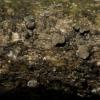
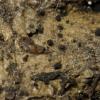
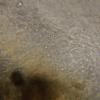
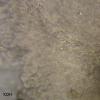
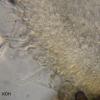
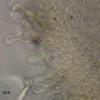
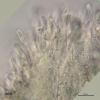
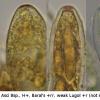
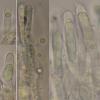
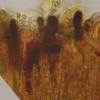
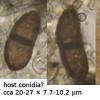
 spores
spores